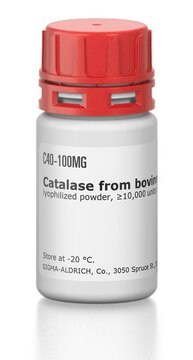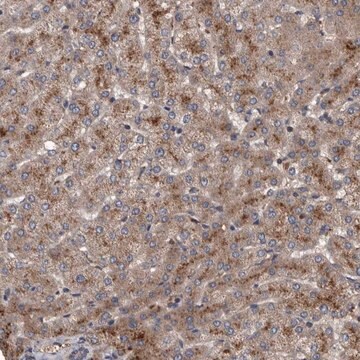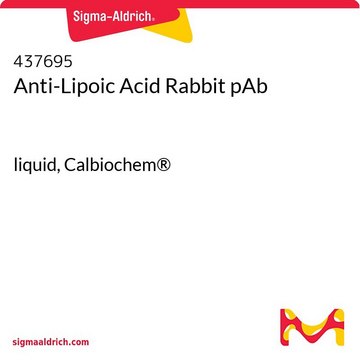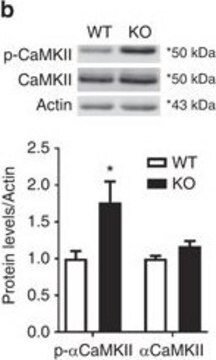General description
Protein AMBP (UniProt P02760; also known as alpha-1-microglobulin/bikunin precursor) is transcribed from the AMBP (also known as HCP, HI30, IATIL, ITIL, ITILC) gene (Gene ID 259) in human as a precursor protein with a signal peptide (a.a. 1-19), posttranslational cleavages produce Alpha-1-microglobulin (a.a. 20-203; A1M, Alpha-1 microglycoprotein, Complex-forming glycoprotein heterogeneous in charge, Protein HC), bikunin (a.a. 206-352; Inter-alpha-trypsin inhibitor light chain, ITI-LC, EDC1, HI-30, Uronic-acid-rich protein), and Trypstatin (a.a. 284-344). Bikunin is a proteoglycan (PG) that contains a single chondroitin sulfate (CS) glycosaminoglycan (GAG) chain with 27-39 monosaccharides attached to Ser10 of the mature core protein. Bikunin GAG has a non-sulfated domain consisting of 6-22 monosaccharides on the non-reducing end and a sulfated domain of 12-18 monosaccharides on the reducing end, with the sulfation occuring exclusively at the fourth carbon of the GalNAc residues. During the synthesis of bikunin by hepatocytes, C-terminal aspartate residues of ~80 kDa heavy chains (HC1 & HC2) are covalently linked to the sixth carbon of a GlcUA residue on the non-sulfated region of the CS chain, forming pre-inter-α-inhibitor (pre-IαI or PαI) with one HC. A second HC can be attached to the non-sulfated region of the CS to form IαI. IαI is known for its roles in inhibiting serine proteinases, such as plasmin, and as an HC donor for the covalent modification of hyaluronan (HA) to form HC·HA (or SHAP·HA) complexes at sites of inflammation and around the oocyte prior to ovulation. Tumor necrosis factor-stimulated gene-6 (TSG-6) forms a covalent HC·TSG-6 intermediate and subsequently transfers the HC to the sixth carbon of GlcNAc residues of HA in a transesterification reaction that contributes to the cross-linking and stabilization of HA matrices; in some contexts modification of HA with HC has been implicated in the promotion of leukocyte adhesion. In addition, the bikunin·CS chain can accept a single HC from IαI via transfer catalyzed by TSG-6 and that HCs could be swapped from bikunin·CS chain to HA. (Briggs, D.C., et al. (2015). J. Biol. Chem. 290(48):28708-28723).
Specificity
This rabbit polyclonal antiserum targets Inter-alpha-trypsin inhibitor light chain (a.a. 206-352; ITI-LC, Bikunin, EDC1, HI-30, Uronic-acid-rich protein) N-terminal sequence, it will also recognize the precursor protein AMBP (a.a. 1-352; alpha-1-microglobulin/bikunin precursor), but not the other two AMBP-derived products, Alpha-1-microglobulin (a.a. 20-203; A1M, Alpha-1 microglycoprotein, Complex-forming glycoprotein heterogeneous in charge, Protein HC) and Trypstatin (a.a. 284-344).
Immunogen
Diphtheria toxoid-conjugated linear peptide corresponding to human bikunin N-terminal sequence.
Application
Research Category
Cell Structure
This rabbit polyclonal Anti-Bikunin Antibody, Cat. No. ABT1346 is validated for use in Immunohistochemistry and Western Blotting.
Western Blotting Analysis: A 1:10,000 dilutioin from a representative lot detected human inter-alpha inhibitor (IαI), pre-alpha-inhibitor (PαI), bikunin·CS, and bikunin (Courtesy of Anthony J Day, University of Manchester, UK).
Western Blotting Analysis: A representative lot detected ~132 kDa Pre-IαI (PαI, bikunin·HC3) in murine airway epithelial cell (AEC) lysate (Abbadi, A., et al. (2015). J. Biol. Chem. 291(3):1448-1455).
Western Blotting Analysis: A representative lot detected ~37 kDa human urine bikunin, as well as the in vitro generated ~125 kDa PαI (bikunin·HC3) by TNF-stimulated gene 6-/TSG-6-catalyzed transfer of a single heavy chain (HC) from mouse serum to the glycosaminoglycan of bikunin using either human urine or purified human urine bikunin (Lamkin, E., et al. (2015). J. Biol. Chem. 290(8):5156-5166).
Immunohistochemistry Analysis: A representative lot localized bikunin immunoreactivity in 10% formalin-fixed (48 h), 5% EDTA-decalcified (14 days), paraffin-embedded human femoral condylar cartilage sections (Yoshihara, Y., et al. (2008). Osteoarthritis Cartilage. 16(11):1343-1355).
Quality
Evaluated by Western Blotting in mouse serum.
Western Blotting Analysis: A 1:500 dilution of this antiserum detected bikunin immunoreactive bands (IαI & PαI) in 44.8 µg of mouse serum proteins.
Target description
~220-250/125-130/45/30 kDa (IαI/PαI/Bikunin·CS/Bikunin) observed. 39.00/15.97 kDa (human AMBP/Bikunin) and 39.03/15.88 kDa (mouse AMBP/Bikunin) calculated. Note that mulitple bikunin-immunoreactive species can be detected in biological samples by Western blotting, including ~37-45 kDa bikunin·CS (Bikunin·chondroitin sulfate), ~30 kDa CS-removed bikunin (size appears larger than calculated due to glycosylation), ~125-130 kDa PαI (bikunin·HC3, pre-alpha-inhibitor, pre-IαI), ~250 kDa IαI (Inter-alpha-trypsin inhibitor or HC1·bikunin·CS·HC2), as well as additional bikunin species of ~55 kDa and ~60 kDa Chondroitinase (Chase) ABC digestion removes CS from bikunin·CS, and thereby releases bikunin PG from PαI and IαI (Lamkin, E., et al. (2015). J. Biol. Chem. 290(8):5156-5166; Yoshihara, Y., et al. (2008). Osteoarthritis Cartilage. 16(11):1343-1355). Uncharacterized bands may be observed in some lysate(s).
Physical form
Rabbit polyclonal antibody serum with 0.05% sodium azide
Unpurified.
Storage and Stability
Stable for 1 year at -20°C from date of receipt.
Handling Recommendations: Upon receipt and prior to removing the cap, centrifuge the vial and gently mix the solution. Aliquot into microcentrifuge tubes and store at -20°C. Avoid repeated freeze/thaw cycles, which may damage IgG and affect product performance.
Other Notes
Concentration: Please refer to lot specific datasheet.
Disclaimer
Unless otherwise stated in our catalog or other company documentation accompanying the product(s), our products are intended for research use only and are not to be used for any other purpose, which includes but is not limited to, unauthorized commercial uses, in vitro diagnostic uses, ex vivo or in vivo therapeutic uses or any type of consumption or application to humans or animals.









